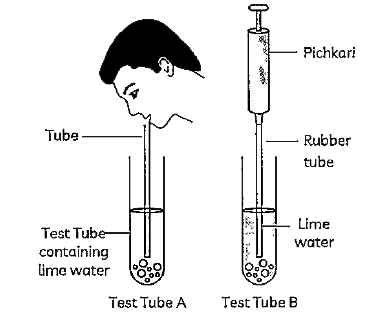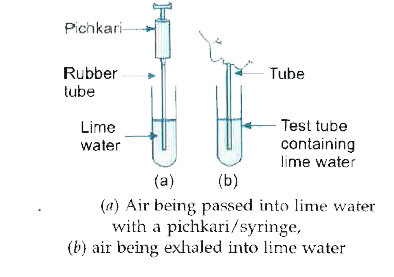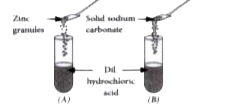A student Rudra took some freshly prepared lime water in two test tubes marked A and B. He blew air through the lime water in test tube A. He then used a syringe or pichkari and passed air through the fresh lime water in test tube B.

Rudra recorded his observations below.
Select the correct observation.
Test Tube A Test Tube B No change observedLime water turned milky immediately
Test Tube A Test Tube B Lime water turned milky immediately No change observed
Test Tube A Test Tube B Lime water turned milky immediately Lime water turned milky after a long time
Test Tube A Test Tube B Lime water turned milky after a long timeLime water turned milky immediately
The correct Answer is:C
Lime water turns milky when carbon dioxide gas ispassed through it as a white precipitate of calcium carbonate is formed when lime water (calcium hydroxide) reacts with carbon dioxide gas.
Lime water turns milky in test tube A as the exhaled air is rich in carbon dioxide. Whereas, lime water takes a lot of time to turn milky in test tube B as the amount of carbon dioxide present in atmesphereic air is very less as compared to exhaled air and hence carbon dioxide is produced after a long time.
Topper's Solved these Questions
Similar Questions
Answer question numbers (a) - (d) on the basis of your understanding of the following paragraph and the related studied concepts :
• Take some freshly prepared lime water in a test tube.
• Blow air through this lime water .
• Note how long it takes for the lime water to turn milky.
• Use a syringe or pichkari to pass air through some fresh lime water taken in another test tube.
(a) What change would you expect in figure 'a' and 'b' ?
(b) Why do you observe the change in 'b' ?
(c) What is the source of this component ?
(d) State the significance of this activity.

View SolutionStudy the set-up given alongside and answer the questions given below:

What will happen to the level of water in test tubes A & B?
View Solution
Knowledge Check
When air is blown from mouth into a test - tube containing lime water, the lime water turned milky due to the presence of
AoxygenBcarbon dioxideCnitrogenDalcohol2mL of ethanoic acid was taken in each of test tube I and test tube II. A red litmus paper was introduced in test tube I and a pH paper was introduced in test tube II. The experiment was performed by four students A,B,C and D and they reported their observations as given below:

The correct set of observations was made by the student:AABBCCDDWhen air is blown from mouth into a test - tube containing lime water, the lime water turned milky due to the presence of
AoxygenBcarbon dioxideCnitrogenDwater vapour
When air is blown from mouth into a test - tube containing lime water, the lime water turned milky due to the presence of
View SolutionA student dropped a few pieces of marble in dilute hydrochloric acid, contained in a test tube, the evolved gas was then passed for a long time through lime water. What changes would be observed in lime water ? Write balanced equations for both the changes observed.
View SolutionApparatus: Two test tubes, bent tube, rubber cork, burner, etc.
Chemicals: Calcium carbonate, freshly prepared lime water.
Procedure: Take some calcium carbonate in a test tube. Fit a bent tube to this test tube with the help of a rubber cork. Insert the other end of the bent tube in the freshly prepared lime water taken in the other test tube. Heat the powdered calcium carbonate in the first test tube strongly.
What will you observe?
View SolutionApparatus: Two test tubes, bent tube, rubber cork, burner, etc.
Chemicals: Calcium carbonate, freshly prepared lime water.
Procedure: Take some calcium carbonate in a test tube. Fit a bent tube to this test tube with the help of a rubber cork. Insert the other end of the bent tube in the freshly prepared lime water taken in the other test tube. Heat the powdered calcium carbonate in the first test tube strongly.
What will you observe?
View SolutionA student took two test tubes, (A) and (B) containing 2 mL of dilute hydrochloric acid and added zinc granules to test tube (A) and solid sodium carbonate to test tube (B) as shown below:

The correct observation would be
View Solution
